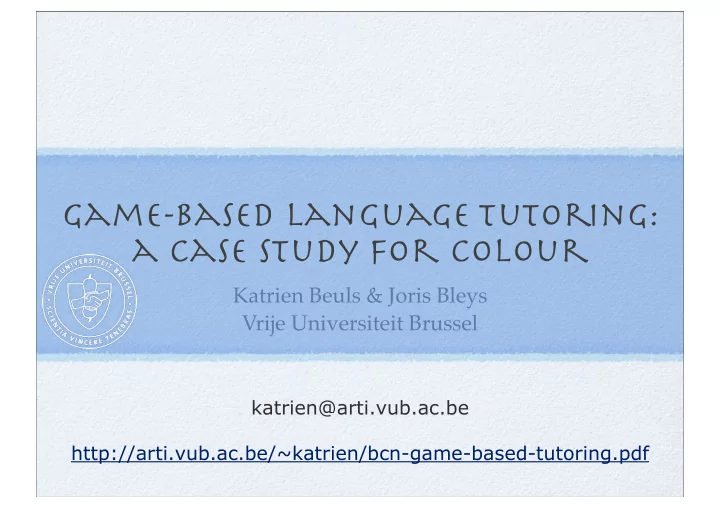

Game-based Language Tutoring: a case study for colour Katrien Beuls & Joris Bleys Vrije Universiteit Brussel katrien@arti.vub.ac.be http://arti.vub.ac.be/~katrien/bcn-game-based-tutoring.pdf
outline 1. Language games in artificial agents Definition and use Implementation: conceptualization, grammar and learning 2. Language games for tutoring purposes Demonstration and preliminary evaluation http://arti.vub.ac.be/~katrien/bcn-game-based-tutoring.pdf
language game Father: Could I have some more water? Mother: ... hands over the wine Father: No, water please. Mother: Sparkling? Father: Yes. Mother: ... pours him some water Father: Thanks.
language game Robot-1: The yellow block. Robot-2: ... points to the orange block. Robot-1: No ... points to the yellow block. Robot-2: The yellow block.
PROPERTIES At least two individuals from a community (recurrent interaction) Common goal as part of situated cooperative actions Common ground Routinised interaction pattern (script) Interaction involves symbols but also gestures and actions
why? Captures communication as primary function of language Allows addressing issues of meaning Incorporates issues of context Language conventions are game/context dependent, not absolute Useful to isolate one specific aspect of language
semiotic cycle speaker hearer sensory-motor grounding grounding streams conceptualization interpretation production parsing speech articulation speech recognition utterance
babel 2 Operationalization of processes in semiotic circle Connection between our core technologies Fluid Construction Grammar (FCG) and Incremental Recruitment Language (IRL) with mechanisms for: multi-agent interactions robotic embodiment cognitive processing learning Extensive monitoring system
learning repair meta-layer processing repair problem problem diagnostic diagnostic diagnostic diagnostic !" !" routine processing
tutoring games Human = tutor; agent = learner Both can be speaker or hearer Human can mediate the flow of the game (select topic, give feedback) Reversed tutoring roles possible (human as a learner)
interaction script 1. Human selects one object in the context 2. Human finds distinctive category for the object and names it 3. Agent looks up category name in memory and examines context to find corresponding object 4. Agent signals intended object 5. Human evaluates choice: failure/success
colour demo Start the game
COnceptualization RGB colour chip mapped in CIE L*a*b* space One nearest-neighbour classification to find category New name => new category [Xu, 2002] Fei Xu. The role of language in acquiring object concepts in infancy. Cognition, 85:223 - 250, 2002.
ALIgnment Update colour category at the end of each successful interaction Shift existing prototype in direction of colour chip values Colour alignment rate specifies new location of protoype ( c n+1 ) linearly between old location ( c n ) and topic ( t ): c n+1 = (1 - r a )c n + r a t
Communicative success 1 or 0 at the end of the game; measure averaged over 10 games Reaches > 80%after 50 games
colour prototypes Positions of colour prototypes after 100 games in CIE L*a*b* space Two basic colour terms uncovered: white and grey 100 German speaking tutor 50 b* 0 -50 -100 -150 -100 -50 0 50 100 150 a*
discussion Previous study [Belpaeme and Bleys, 2009] has shown that pre-programmed agents can consistently name 83% of colour chips 90% correctly named chips in CTG BUT ! Human tutor can avoid difficult chips => measure reflects similarity in human + agent categories
future work Evaluation of the system Extension to other domains: Convert existing language game experiments: quantifiers [Pauw and Hilferty 2011], case systems [van Trijp, 2011], spatial language [Spranger et al., 2010] Simon Pauw and Joseph Hilferty. The Emergence of Quantification. In Luc Steels, editor, Experiments in Language Evolution. John Benjamins, Amsterdam, in press. Remi van Trijp. The Emergence of a Case Grammar. In Luc Steels, editor, Experiments in Language Evolution. John Benjamins, Amsterdam, in press. Michael Spranger, Simon Pauw and Martin Loetzsch. Open-ended Semantics co-evolving with Spatial Language. In Proceedings of EVOLANG 8 , 2010.
thank you! http://arti.vub.ac.be/~katrien/bcn-game-based-tutoring.pdf
Recommend
More recommend